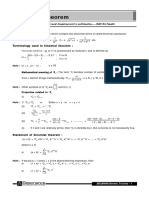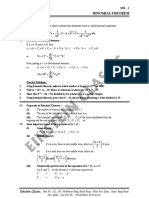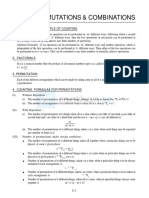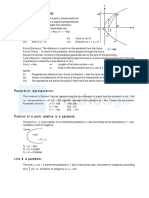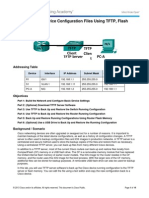Statement of Binomial Theorem
Uploaded by
Arya NairStatement of Binomial Theorem
Uploaded by
Arya NairBINOMIAL THEOREM
1. Statement of Binomial theorem : If a, b ∈ R and n ∈ N, then
n
n n
(a + b) = C0 a b + C1 a n 0 n n–1 1
b + C2 a n n–2 2
b +...+ Cr a n n–r r n
b +...+ Cn a b = 0 n ∑
r =0
n
Cr an −r b r
n n n n 2 n r n n
(1 + x) = C0 + C1 x + C2 x +... + Cr x +...+ Cn x
2. Properties of Binomial Theorem :
(i) The number of terms in the expansion is n + 1.
(ii) The sum of the indices of a and b in each term is n.
(iii) The binomial coefficients (n C0, nC1 .......... nCn) of the terms equidistant from the beginning and
the end are equal, i.e. n C0 = n Cn , n C1 = n Cn–1 etc. {Q nCr = nCn–r}
(iv) General term : T r+1 = n Cr an–r br
(v) Middle term (s) :
n+2
(a) If n is even, there is only one middle term, which is th term.
2
n + 1 n+1
(b) If n is odd, there are two middle terms, which are th and + 1 th terms.
2 2
(vi) Numerically greatest term in the expansion of (x + y) , n ∈ N
n
(n + 1) | y | (n + 1) | y |
Let r = | x | + | y | . If | x | + | y | is not an integer, then t r + 1 is numerically greatest.
(n + 1) | y |
If | x | + | y | is an integer, then t r = t r + 1 and both are numercally greatest.
∑
n!
3. Multinomial Theorem : (x 1 + x 2 + x 3 + ........... x k)n = x 1r1 . x r22 ...x rkk
r1 +r2 +...+ rk =n
r1! r2 !... rk !
n+k–1
Here total number of terms in the expansion = Ck–1
4. Application of Binomial Theorem :
If ( A + B) = Ι + f where Ι and n are positive integers, n being odd and 0 < f < 1 then (Ι + f)
n
f = kn where A – B2 = k > 0 and A – B < 1.
If n is an even integer, then (Ι + f) (1 – f) = kn
5. Properties of Binomial Coefficients :
n
(i) C0 + n C1 + n C2 + ........+ n Cn = 2n
n
(ii) C0 – n C1 + n C2 – n C3 + ............. + (–1)n n Cn = 0
n
(iii) C0 + n C2 + n C4 + .... = n C1 + n C3 + n C5 + .... = 2n–1
n
n n n+1
Cr n −r +1
(iv) Cr + Cr–1 = Cr (v) n =
Cr −1 r
You might also like
- Bionomial Theoram and Mathematical InductionNo ratings yetBionomial Theoram and Mathematical Induction3 pages
- 10 Binomial Theorem Formula Sheets QuizrrNo ratings yet10 Binomial Theorem Formula Sheets Quizrr5 pages
- 10 Binomial Theorem Formula Sheets QuizrrNo ratings yet10 Binomial Theorem Formula Sheets Quizrr4 pages
- Binomial Expression: y X X Q X P y X B ANo ratings yetBinomial Expression: y X X Q X P y X B A3 pages
- Class 11 Mathematics Topic Wise Line by Line Chapter 7 Binomial TheoremNo ratings yetClass 11 Mathematics Topic Wise Line by Line Chapter 7 Binomial Theorem54 pages
- Binomial Theorem - Formulas, Properties, Terms in Binomial Expansion, Examples (with PDF)No ratings yetBinomial Theorem - Formulas, Properties, Terms in Binomial Expansion, Examples (with PDF)18 pages
- Binomial Theorem: Theory and Exercise BookletNo ratings yetBinomial Theorem: Theory and Exercise Booklet8 pages
- Binomial Theorem and Principle of Mathematical InductionNo ratings yetBinomial Theorem and Principle of Mathematical Induction8 pages
- 10 Binomial Theorem Formula Sheets Getmarks AppNo ratings yet10 Binomial Theorem Formula Sheets Getmarks App5 pages
- Binomial Theorem (For A Positive Integral Index)No ratings yetBinomial Theorem (For A Positive Integral Index)2 pages
- Binomial Theorem _ Short Notes __ Arjuna JEE 2.0 2024No ratings yetBinomial Theorem _ Short Notes __ Arjuna JEE 2.0 20241 page
- Binomial Theorem _ Short Notes __ Arjuna JEE 2024No ratings yetBinomial Theorem _ Short Notes __ Arjuna JEE 20241 page
- Aakash - Binomial Theorem and Its ApplicationNo ratings yetAakash - Binomial Theorem and Its Application8 pages
- Binomial Theorem Notes For JEE Main - pdf-18No ratings yetBinomial Theorem Notes For JEE Main - pdf-185 pages
- Binomial Theorem - Formula Sheet - MathonGo100% (1)Binomial Theorem - Formula Sheet - MathonGo3 pages
- De Moiver's Theorem (Trigonometry) Mathematics Question BankFrom EverandDe Moiver's Theorem (Trigonometry) Mathematics Question BankNo ratings yet
- Trigonometric Ratios to Transformations (Trigonometry) Mathematics E-Book For Public ExamsFrom EverandTrigonometric Ratios to Transformations (Trigonometry) Mathematics E-Book For Public Exams5/5 (1)
- Factoring and Algebra - A Selection of Classic Mathematical Articles Containing Examples and Exercises on the Subject of Algebra (Mathematics Series)From EverandFactoring and Algebra - A Selection of Classic Mathematical Articles Containing Examples and Exercises on the Subject of Algebra (Mathematics Series)No ratings yet
- 10+2 Level Mathematics For All Exams GMAT, GRE, CAT, SAT, ACT, IIT JEE, WBJEE, ISI, CMI, RMO, INMO, KVPY Etc.From Everand10+2 Level Mathematics For All Exams GMAT, GRE, CAT, SAT, ACT, IIT JEE, WBJEE, ISI, CMI, RMO, INMO, KVPY Etc.No ratings yet
- Mathematical Formulas for Economics and Business: A Simple IntroductionFrom EverandMathematical Formulas for Economics and Business: A Simple Introduction4/5 (4)
- Hyperbola: Equation of Hyperbola in Standard FormNo ratings yetHyperbola: Equation of Hyperbola in Standard Form7 pages
- Ellipse: Equation of An Ellipse in Standard FormNo ratings yetEllipse: Equation of An Ellipse in Standard Form8 pages
- 11.4.2.7 Lab - Managing Device Configuration FilesNo ratings yet11.4.2.7 Lab - Managing Device Configuration Files14 pages
- Manufacturing Process of Dilmah Tea Company100% (1)Manufacturing Process of Dilmah Tea Company9 pages
- 1970 Developments in Triaxial Testing TechniqueNo ratings yet1970 Developments in Triaxial Testing Technique6 pages
- Systems Engineering - 2023 - Scalco - A Model For Measuring Multi Concern Assurance of Critical Infrastructure ControlNo ratings yetSystems Engineering - 2023 - Scalco - A Model For Measuring Multi Concern Assurance of Critical Infrastructure Control12 pages
- 2Ch404-Chemical Engineering Thermodynamics: Tutorial-1 21BCH021No ratings yet2Ch404-Chemical Engineering Thermodynamics: Tutorial-1 21BCH0216 pages
- Traffic Congestion Problem and SolutionsNo ratings yetTraffic Congestion Problem and Solutions11 pages
- Marantec Comfort 220 Installation InstructionsNo ratings yetMarantec Comfort 220 Installation Instructions140 pages
- Research Article: An Empirical Study of Machine Learning Algorithms For Stock Daily Trading StrategyNo ratings yetResearch Article: An Empirical Study of Machine Learning Algorithms For Stock Daily Trading Strategy31 pages
- Fine Roller Mill Alpha Ii: Type ALPHA II: The Standard of Hydraulic High-Performance Roller Mills, For Roller GapsNo ratings yetFine Roller Mill Alpha Ii: Type ALPHA II: The Standard of Hydraulic High-Performance Roller Mills, For Roller Gaps8 pages
- Oil & Gas Industry Interview Questions Answers100% (1)Oil & Gas Industry Interview Questions Answers13 pages
- Google Sheets CountIf and ImportRange Return 0 and Won't Offer To Allow AccessNo ratings yetGoogle Sheets CountIf and ImportRange Return 0 and Won't Offer To Allow Access2 pages
- 32.power System Study-Sc, RC & Dynamic Testing100% (2)32.power System Study-Sc, RC & Dynamic Testing136 pages
- Science Process Skills: Observe Classify Measure Infer Predict Credits Extensions About The AuthorNo ratings yetScience Process Skills: Observe Classify Measure Infer Predict Credits Extensions About The Author21 pages





